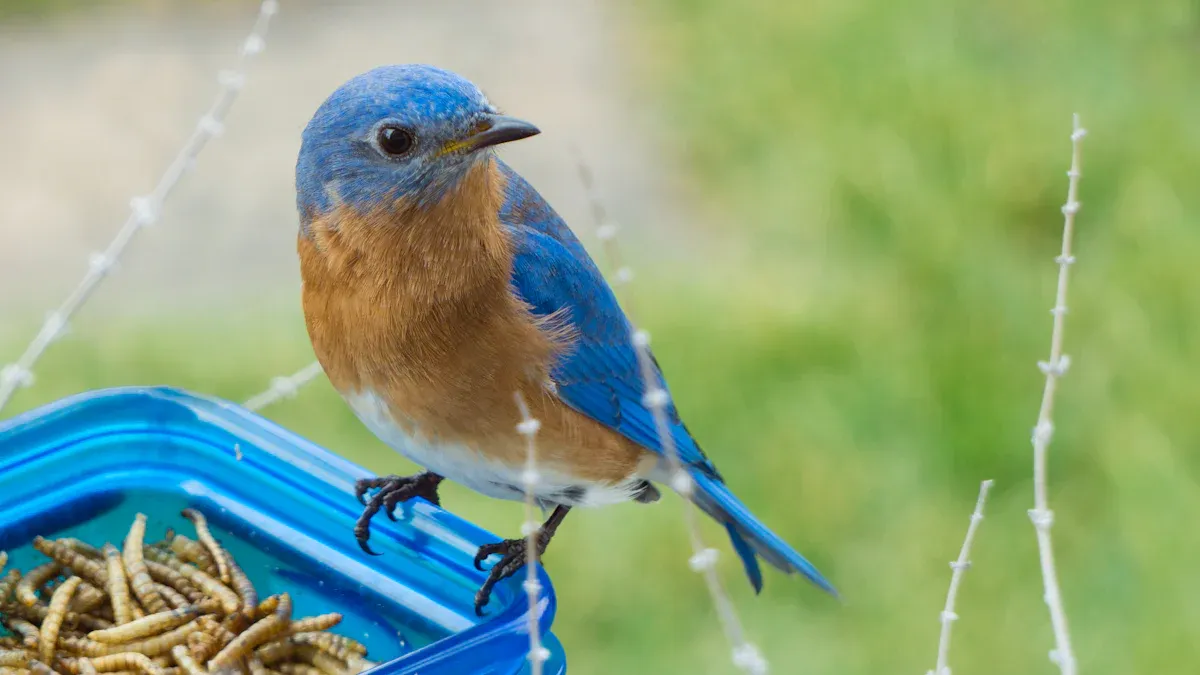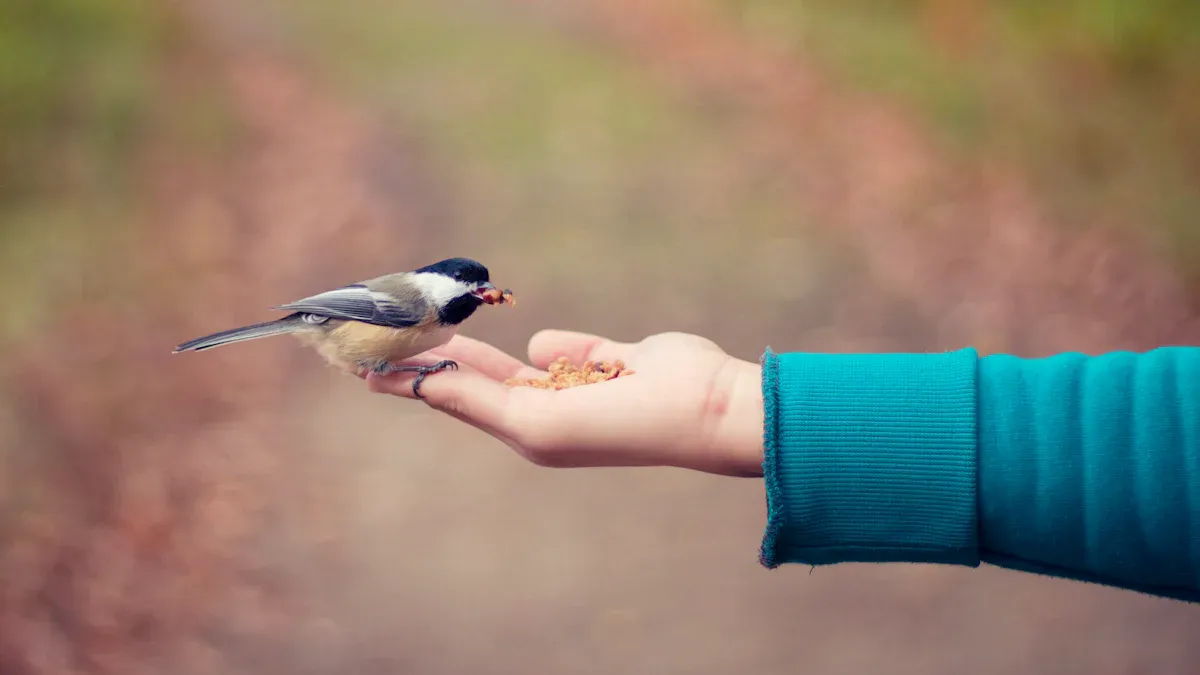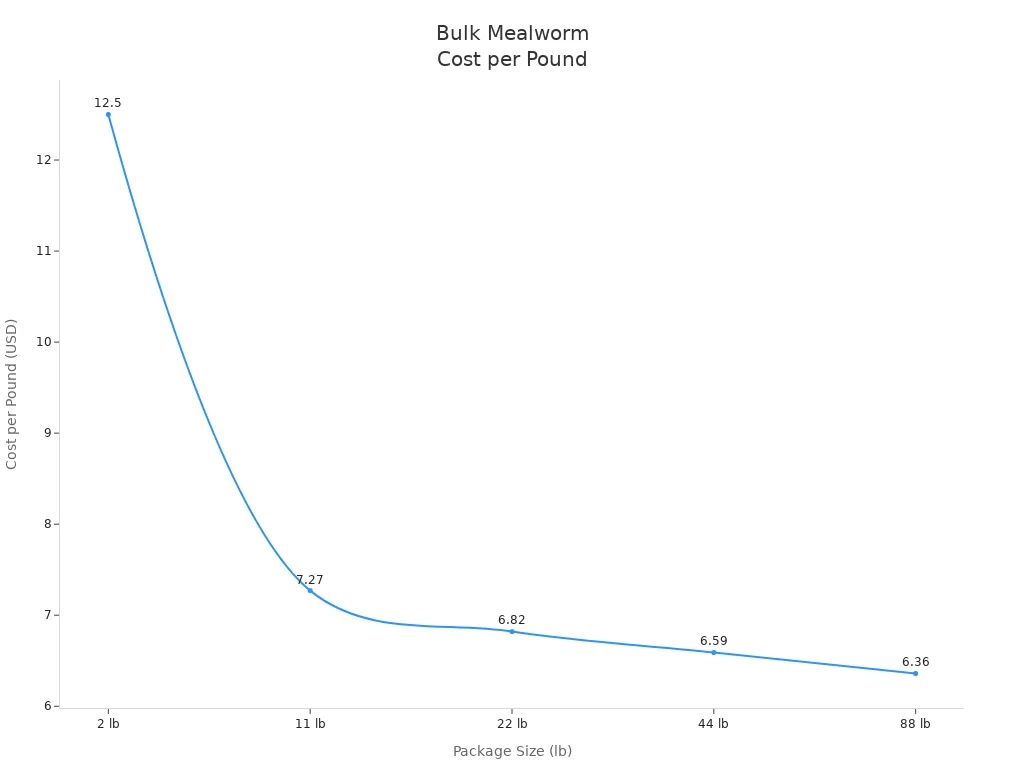
Many birds thrive on a diet that includes dry mealworms for birds. These mealworms offer a concentrated source of protein and fat, with about 50-55% protein and 24-28% fat. Birds benefit from this nutrient-rich food, but nestlings need extra moisture, so rehydrated or live mealworms work best for them.
Key Takeaways
- Dry mealworms provide birds with essential protein and fat that support their health, especially during breeding, migration, and cold weather.
- Rehydrate dry mealworms before feeding young birds to make them easier to eat and prevent dehydration; adult birds can eat them dry.
- Store dry mealworms in sealed containers in cool, dry places or the refrigerator to keep them fresh and free from pests.
Which Birds Eat Dry Mealworms for Birds

Common Backyard Birds
Many backyard birds enjoy eating dry mealworms for birds. These mealworms provide a rich source of protein and fat, making them a favorite among several species. Some of the most common backyard birds that visit feeders for dried mealworms include:
- Chickadees, which quickly become regular visitors when mealworms are available.
- Nuthatches, such as Red-Breasted and White-Breasted, often seek out mealworms.
- Downy Woodpeckers and Hairy Woodpeckers, which supplement their diet with mealworms.
- Northern Cardinals, known for their bright colors and strong beaks.
- Tufted Titmice, small birds that often travel in mixed flocks.
- Wrens, which are primarily insect eaters but readily consume mealworms.
- Chipping Sparrows, which add variety to backyard birdwatching.
These birds find mealworms easy to eat and digest. Many bird enthusiasts notice that offering dried mealworms attracts a wider variety of birds to their feeders.
Seasonal Visitors
During migration and breeding seasons, some birds visit feeders more frequently in search of high-energy foods. Dried mealworms help fuel these birds during long flights and nesting periods. Seasonal visitors that often eat mealworms include:
- Bluebirds, especially during migration and breeding.
- Thrushes, which need extra protein for their journeys.
- Buntings and Catbirds, which stop by feeders in spring and fall.
- Orioles, Robins, and Tanagers, which benefit from mealworms during nesting.
- Flycatchers, Grosbeaks, and Tits, which require extra nutrition.
- Warblers and Wrens, which are active and energetic.
- Woodpeckers, such as Downy and Hairy, which rely on mealworms when insects are scarce.
- Nuthatches, which sometimes carry mealworms to their nests for their young.
Mealworms, including dried varieties, attract bluebirds, woodpeckers, and chickadees during spring migration and breeding. These birds depend on the protein and fat in mealworms to stay healthy and strong.
Tip: Offering dry mealworms for birds during migration can help support their energy needs and increase the variety of birds visiting your yard.
Birds to Avoid Feeding
Not all birds benefit from eating mealworms. Some species do not digest animal protein well or may not need the extra fat and protein. For example, most seed-eating finches, doves, and pigeons do not show interest in mealworms. Hummingbirds and other nectar feeders also do not eat mealworms, as their diet consists mainly of sugar-rich nectar. Avoid offering mealworms to birds that do not naturally eat insects, as this can disrupt their normal feeding habits.
Benefits of Dry Mealworms for Birds
Nutrition and Health
Dry mealworms for birds offer important nutrients that help wild birds stay healthy throughout the year. These mealworms supply protein, fat, and fiber, which birds need for many life stages. Birds use the extra protein to grow strong feathers, lay eggs, and feed their chicks. The fat in mealworms helps birds stay warm during cold weather. Many birds rely on mealworms when natural food becomes scarce, especially in winter.
- Mealworms provide energy for nesting, egg laying, and raising young.
- They help birds survive harsh weather and migration.
- Both live and dried mealworms give birds valuable nutrition, but dried mealworms are easier to store and serve.
Note: Offering mealworms during winter or breeding season can support bird health and increase survival rates.
Convenience and Versatility
Dried mealworms make feeding wild birds simple and flexible. Unlike live insects, dried mealworms do not move or escape, so they are easy to handle. They last a long time on the shelf and do not spoil quickly, even after opening. Bird lovers can store them in bulk and use them as needed.
- Dried mealworms can be offered alone or mixed with seeds and suet.
- They are easy to portion, so feeders can control how much they give.
- Soaking dried mealworms in water for 30 minutes makes them softer and more appealing to some birds.
Many people choose dry mealworms for birds because they are convenient, nutritious, and suitable for many feeding methods.
How to Prepare Dry Mealworms for Birds
Rehydrating for Better Appeal
Many birds prefer mealworms that are soft and moist. Rehydrating dried mealworms makes them juicier and easier to eat. This process involves soaking the mealworms in warm water for 10 to 60 minutes. During soaking, the mealworms double in size and regain moisture. Birds find these plumper mealworms more appealing, especially during the breeding season.
- Rehydrated mealworms become softer, which helps young chicks digest them more easily.
- The added moisture improves palatability but does not change the nutritional value.
- Soaked mealworms can be mixed with other foods to attract a wider range of birds.
Tip: Always use clean, warm water for soaking. After rehydration, serve the mealworms promptly to avoid spoilage or bacterial growth.
Birds need extra hydration during hot weather or when feeding their young. Offering rehydrated mealworms supports their health and makes feeding easier for parent birds. Many bird enthusiasts notice that bluebirds, wrens, and robins visit more often when they offer rehydrated mealworms.
| Step | Action | Time Needed |
|---|---|---|
| 1. Measure | Place desired amount in a bowl | 1 minute |
| 2. Add Warm Water | Cover mealworms with warm water | 1 minute |
| 3. Soak | Let mealworms soak and plump up | 10-60 minutes |
| 4. Drain | Remove excess water before serving | 1 minute |
Serving rehydrated mealworms is especially important for nestlings and fledglings. Dry mealworms can absorb moisture inside the stomach of young birds, which may cause dehydration. Soaking the mealworms first helps prevent this risk and ensures safe feeding.
Using Dry Mealworms Straight from the Bag
Dry mealworms for birds offer a convenient feeding option. Many adult birds enjoy them straight from the bag. These mealworms are easy to store, handle, and portion. Bird lovers can pour them directly into feeders or mix them with seeds and suet.
- Dry mealworms last longer than live or rehydrated ones.
- They do not spoil quickly and require no refrigeration.
- Mixing dry mealworms with other foods increases their appeal to different bird species.
Note: While adult birds can eat dry mealworms safely, young birds need extra moisture. During the breeding season, always soak mealworms before offering them to families with chicks.
Serving dry mealworms straight from the bag works well for most backyard birds. However, bird enthusiasts should watch for signs of dehydration in young birds and adjust feeding methods as needed. Offering water nearby also helps birds digest dry foods more easily.
Serving Dry Mealworms for Birds
Best Types of Feeders
Bird feeders come in many shapes and sizes. Some work better for serving dry mealworms for birds. The best feeders keep mealworms dry, safe, and easy for birds to reach. Many bird lovers choose feeders with these features:
- Tall sides to stop mealworms from falling out
- A roof or rain guard to protect from moisture
- Drainage holes to prevent water buildup
- Tamper-resistant designs to keep out squirrels and pests
- Hanging feeders with lids or domes for extra protection
- Tray feeders for easy access, especially for birds that like to perch
These features help keep mealworms fresh and make feeding simple for both birds and people.
Mixing with Other Foods
Many birds enjoy a mix of foods. People often combine dried mealworms with seeds or suet. This mix attracts more types of birds, especially those that eat insects. Bluebirds, chickadees, cardinals, nuthatches, woodpeckers, and wrens all visit feeders with this blend. Mixing mealworms with other foods gives birds a high-protein treat. During nesting season, this mix helps parent birds feed their young. Sometimes, birds need time to try new foods. Once one bird eats the mealworms, others often follow.
Tip: Slightly moisten dried mealworms before mixing to make them even more appealing, but do not leave them damp for long.
Where and When to Offer
Place feeders in quiet spots where birds feel safe. Hang them near shrubs or trees for cover. Offer dry mealworms for birds year-round. Birds need extra protein during breeding, migration, and cold weather. Early morning and late afternoon are the best times to refill feeders. Birds visit most often during these hours. Keep feeders clean and check for spoiled food after rain.
How Much and How Often to Feed Dry Mealworms for Birds
Recommended Serving Sizes
Birds benefit most from mealworms when served in moderation. Experts suggest offering no more than one to two beakfuls of dry mealworms per bird each day. This amount equals about 10% of a bird’s daily food intake. A small handful, or roughly one tablespoon, works well for most backyard feeders. This serving size gives birds enough protein without replacing other important foods. Mixing dry mealworms with seeds or suet helps create a balanced diet. This approach ensures birds receive a variety of nutrients.
Frequency of Feeding
Feeding dry mealworms regularly encourages birds to visit feeders often. Many bird enthusiasts offer mealworms once or twice a week. This routine keeps birds interested and helps them accept mealworms as part of their diet. Dried mealworms can be offered year-round, especially during breeding, migration, or cold weather. However, they should not be the only food available. Providing mealworms alongside seeds, suet, and native insects supports a healthy and balanced diet. Always remove uneaten, moistened mealworms after a day or two to prevent spoilage.
Signs of Overfeeding
Overfeeding dry mealworms can harm bird health. Watch for these signs:
- Birds appear lethargic or less active
- Reduced egg production in nesting birds
- Noticeable weight gain or difficulty moving
- Signs of kidney strain, such as puffed feathers or illness
Mealworms should make up only a small part of a bird’s diet. Feeding in moderation helps prevent health problems and keeps backyard birds strong and active. Regular visual checks and monitoring bird behavior help ensure a safe and enjoyable feeding experience.
Safe Storage Tips for Dry Mealworms for Birds
Keeping Mealworms Fresh
Dry mealworms last much longer than live mealworms. Proper storage helps keep them fresh and nutritious for birds. People should use a sealed plastic or glass container to store dry mealworms. This keeps out air and moisture, which can cause spoilage. For short-term storage, a cool, dark place like a pantry works well. For longer storage, the refrigerator is best. The ideal temperature is between 40°F and 50°F (4.4°C to 10°C). Storing dry mealworms in the fridge door can extend their shelf life up to a year.
Tip: Always keep dry mealworms away from direct sunlight and heat. High temperatures can reduce freshness and attract pests.
A table can help summarize the best storage methods:
| Storage Method | Shelf Life | Notes |
|---|---|---|
| Pantry (sealed) | Up to 6 months | Keep cool and dry |
| Refrigerator (sealed) | Up to 12 months | Best for long-term freshness |
Avoiding Pests and Mold
Pests and mold can spoil dry mealworms quickly. Common pests include grain mites, beetles, and moths. Mold grows when moisture builds up inside the container. To prevent these problems, people should:
- Use airtight containers to block pests.
- Store mealworms in a dry, cool place with good ventilation.
- Check for moisture and remove any dampness right away.
- Clean storage containers every two weeks to remove crumbs and waste.
- Inspect mealworms regularly for signs of pests or mold.
Note: Removing spilled food and cleaning storage areas helps keep pests away. Regular checks ensure mealworms stay safe and healthy for birds.
Cost-Saving Tips and DIY Ideas for Dry Mealworms for Birds
Buying in Bulk
Bird enthusiasts can save money by purchasing dry mealworms in larger quantities. The cost per pound drops as the package size increases. This approach helps families feed birds regularly without overspending. The following table shows how the price per pound decreases with bigger packages:
| Package Size (lb) | Price (USD) | Cost per Pound (USD) |
|---|---|---|
| 2 | 24.99 | 12.50 |
| 11 | 79.99 | 7.27 |
| 22 | 149.99 | 6.82 |
| 44 | 289.99 | 6.59 |
| 88 | 559.99 | 6.36 |

Buying in bulk not only reduces costs but also ensures a steady supply of nutritious mealworms for birds throughout the year.
Making Your Own Mealworm Feeder
Creating a homemade feeder can make bird feeding more affordable and fun. Several simple designs work well for dry mealworms:
- Wood-based feeder: Use a thick board, clear plexiglass, and basic tools. Drill entrance holes and add grooves for easy access.
- Plastic bottle feeder: Repurpose a large plastic jar or bottle. Cut holes for birds and use the cap for easy cleaning.
- Feeder modifications: Add perches, entrance holes near the floor, or hanging cables to attract more birds.
These designs attract bluebirds, robins, and other backyard favorites. Homemade feeders also allow for customization based on local bird species.
Stretching Your Supply
Bird lovers can stretch their supply of dry mealworms without sacrificing nutrition. Some effective methods include:
- Mixing mealworms with seeds, suet, or commercial hand-feeding mixes.
- Adding small amounts of wheat germ, powdered milk, or brewers yeast.
- Rehydrating mealworms with water or a few drops of vegetable oil.
- Supplementing with other insects or chopped fruits like raisins.
- Offering smaller portions alongside other foods.
These strategies help maintain a balanced diet for birds and make each bag of mealworms last longer.
Avian experts recommend several best practices for using dry mealworms for birds:
- Offer small amounts as a treat, not a staple.
- Moisten mealworms slightly, but remove damp ones within two days.
- Use feeders with tall sides, roofs, and drainage holes.
- Store mealworms sealed to keep them fresh.
Safe feeding keeps birds healthy and encourages enjoyable birdwatching.
FAQ
Can birds eat dry mealworms every day?
Birds can eat dry mealworms daily as a treat. They need a balanced diet with seeds, fruits, and insects for best health.
Tip: Offer mealworms with other foods for variety.
Do dry mealworms need to be soaked before feeding?
Soaking dry mealworms makes them softer and easier for birds to eat. This step helps young birds and parent birds during nesting season.
How should people store dry mealworms?
People should store dry mealworms in a sealed container. A cool, dry place or refrigerator keeps them fresh and safe from pests.


